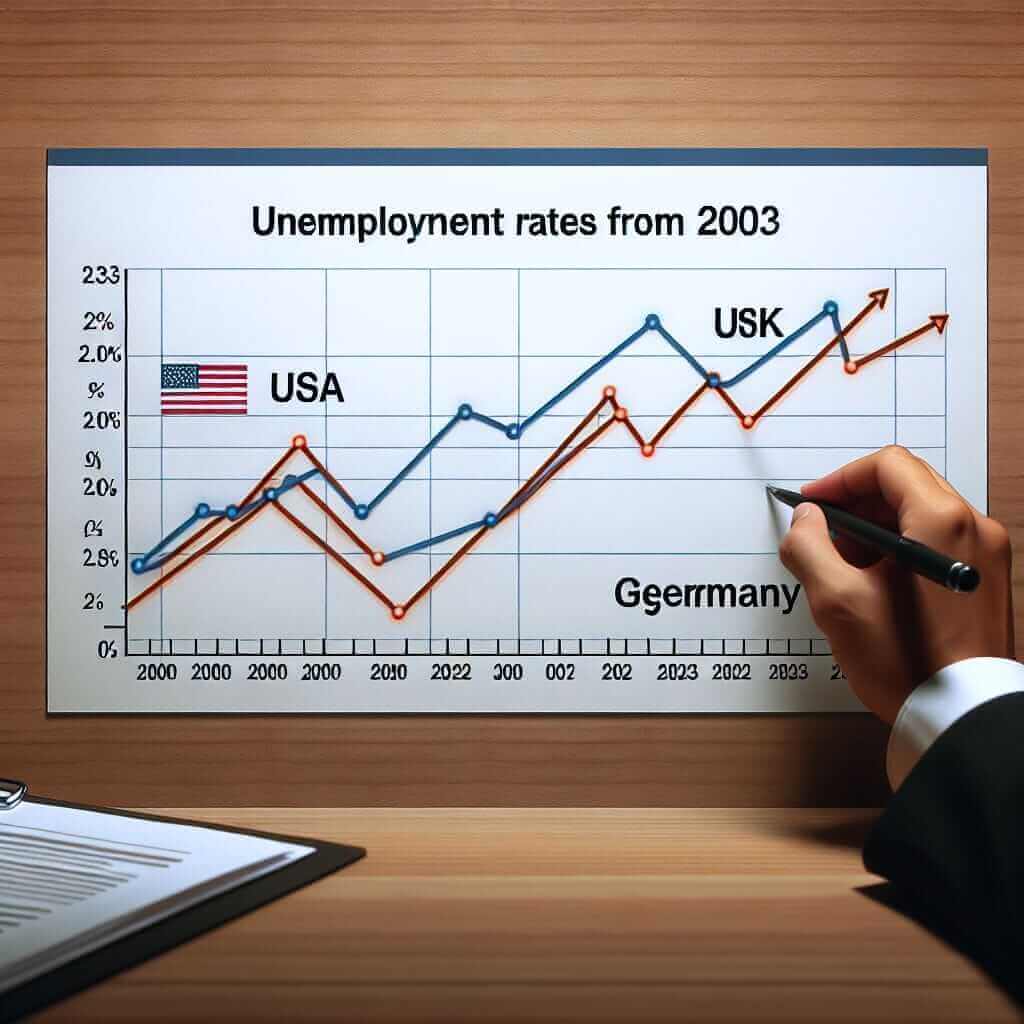The IELTS Writing Task 1 often presents you with visual data, such as line graphs, bar charts, or tables, requiring you to summarize the information in a clear and concise manner. One common theme in these tasks is comparing trends across different countries. A typical example is analyzing unemployment rates. This article will guide you through the process of writing a band-scoring IELTS report on comparing unemployment rates in the USA, UK, and Germany, providing essential tips and vocabulary to help you achieve your target score.
Sample IELTS Writing Task 1 Question
You should spend about 20 minutes on this task.
The line graph below shows the unemployment rates in the USA, the UK, and Germany from 2000 to 2023.
Write a report of at least 150 words describing the information shown in the graph.
(Please note: For this exercise, we will use hypothetical data as accessing real-time data for the entire period is not feasible. However, the principles and techniques discussed will be applicable to real IELTS exams.)
Hypothetical Data and Line Graph
| Year | USA (%) | UK (%) | Germany (%) |
|---|---|---|---|
| 2000 | 4.0 | 4.5 | 7.5 |
| 2005 | 5.5 | 5.0 | 9.0 |
| 2010 | 9.5 | 8.0 | 7.0 |
| 2015 | 5.0 | 5.5 | 4.5 |
| 2020 | 8.0 | 4.0 | 5.0 |
| 2023 | 6.0 | 4.5 | 4.0 |
(Imagine a line graph representing this data with the years on the x-axis and unemployment rates on the y-axis. Each country should have a distinct line representing its unemployment rate trend.)
 Unemployment Rates in the USA, UK, and Germany (2000-2023)
Unemployment Rates in the USA, UK, and Germany (2000-2023)
Analysis of the Task
This task requires you to:
- Identify the main trends: Analyze how unemployment rates have changed over time in each country.
- Compare and contrast: Highlight any similarities or differences in the unemployment patterns of the three countries.
- Use data accurately: Support your description with figures from the graph.
Model Answer
The line graph illustrates the fluctuations in unemployment rates for the USA, the UK, and Germany over a 23-year period, from 2000 to 2023.
At the start of the millennium, the USA enjoyed the lowest unemployment rate at 4%, followed by the UK at 4.5%, while Germany had the highest rate at 7.5%. Over the next five years, unemployment rose in both the USA and Germany, peaking at 5.5% and 9% respectively in 2005. In contrast, the UK witnessed a slight decline in unemployment during the same period.
The year 2010 marked a significant shift, with the USA experiencing a sharp surge in unemployment to 9.5%, triggered by the global financial crisis. Conversely, Germany’s unemployment rate fell to 7%, while the UK’s remained relatively stable at 8%.
The latter half of the period saw a downward trend in unemployment rates across all three countries. By 2015, the USA and the UK had comparable rates of around 5%, while Germany boasted the lowest rate at 4.5%. Although the USA experienced another spike in unemployment in 2020, reaching 8%, the rate fell to 6% by 2023. Notably, both the UK and Germany maintained relatively low unemployment rates throughout the later years, ending at 4.5% and 4% respectively in 2023.
Word count: 189 words
Key Points to Remember
- Paraphrase the question: Never copy the question directly. Rephrase it using synonyms and different sentence structures.
- Overview: Provide a general overview of the graph’s main features in the introduction.
- Body paragraphs: Divide the information into clear paragraphs, focusing on significant trends.
- Data comparison: Use comparative language (higher than, lower than, similar to) to highlight differences and similarities.
- Accurate data: Include specific figures from the graph to support your points.
- Tenses: Use the appropriate tenses to describe the time frame presented in the graph.
- Conclusion: Summarize the key trends and avoid introducing new information.
Useful Vocabulary
- Fluctuations: ups and downs, variations
- Surge: a sudden and significant increase
- Decline: a decrease, a downward trend
- Conversely: on the other hand, in contrast
- Triggered by: caused by, initiated by
- Boasted: had, possessed (used to emphasize a positive aspect)
- Comparable: similar, alike
- Maintained: kept, sustained
Difficult Vocabulary
- Fluctuations (noun /ˌflʌk.tʃuˈeɪ.ʃənz/): irregular rising and falling in number or amount; variations.
- Surge (noun/verb /sɝːdʒ/): a sudden and great increase.
- Conversely (adverb /ˈkɑːn.vɝːs.li/): in the opposite way.
- Triggered (verb /ˈtrɪɡ.ɚd/): caused to start suddenly.
- Boasted (verb /boʊstɪd/): (used to emphasize a positive aspect) had.
Conclusion
Mastering the art of describing and comparing data in IELTS Writing Task 1 is crucial for achieving a high band score. By understanding the task requirements, using appropriate vocabulary, and practicing regularly, you can confidently tackle any line graph comparing economic indicators like unemployment rates. Remember, clarity, accuracy, and concise language are key to success in this section.


